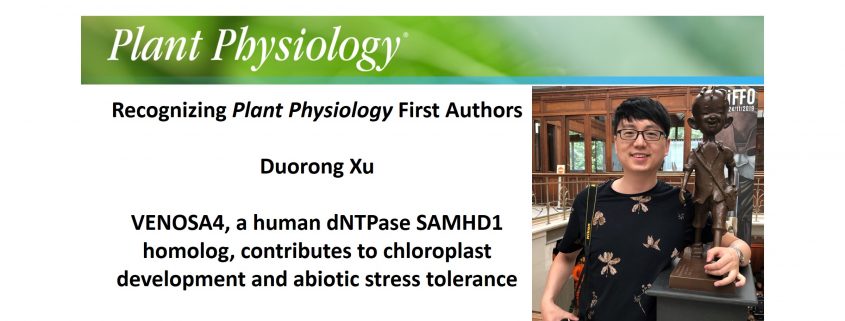Recognizing Plant Physiology authors: Duorong Xu
Duorong Xu, first author of VENOSA4, a human dNTPase SAMHD1 homolog, contributes to chloroplast development and abiotic stress tolerance
Current Position: PhD candidate in the group of PD Dr. Tatjana Kleine, Leister lab, Ludwig-Maximilians-University of Munich, Germany
Education: M.S. in Cell Biology, Lanzhou University, B.S. in Biotechnology, Gansu Agricultural University, China
Non-scientific Interests: traveling, swimming, photography, badminton
Brief bio: Our previous study demonstrated a role for the extrachloroplastic protein PP7L in chloroplast development and abiotic stress. During our study, a bit in a serendipitous way, we found phyB-9 and oePHYB(phyB-9) might harbor a previously unknown second mutation which plays a major role in PSII function. As we attempt to identify this putative second mutation, Yoshida et al. (2018) shows the second-site mutation was localized to the VENOSA4 gene. In this work, our results indicate that VENSOSA4 is required for chloroplast biogenesis by maintaining balanced dNTP pools. In the future, I hope to understand the molecular mechanisms that extrachloroplastic proteins control chloroplast development in plants.
姓名: 徐多荣
目前职位: 博士研究生,Leister实验室, Tatjana Kleine课题组,慕尼黑大学
教育经历:兰州大学,细胞生物学,硕士;甘肃农业大学,生物技术,学士
兴趣爱好:旅游,游泳,摄影,羽毛球
个人简介:
我们之前的研究证明非叶绿体蛋白PP7L是拟南芥叶绿体正常发育所必须的,缺失PP7L会使得植物对非生物胁迫更加敏感。在研究这个课题时,我们意外的发现phB-9 突变体和oe-PHYB (phyB-9)可能含有未知的第二突变位点,且这个突变位点对叶绿体光系统II的功能至关重要。正当我们尝试鉴定这个第二突变位点时,Yoshida 等人(2018)在Plant Physiology率先发文证明这个第二突变位于VENOSA4基因。我们最新的研究结果表明VENOSA4可能通过代谢不同的dNTP来维持体内dNTP池的平衡,细胞内dNTP的稳态进一步影响叶绿体的发育。我们未来的研究重点将集中于揭示非叶绿体蛋白调控叶绿体发育的分子机制。




